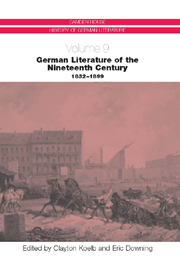Book contents
- Frontmatter
- Contents
- Illustrations
- Introduction
- Part I Contexts
- Part II Movements
- Literary Controversy: Naming and Framing the Post-Romantic, Pre-Realist Period
- Poetic Realism, Naturalism, and the Rise of the Novella
- Literary Movements of the 1890s: Impressionism, Symbolism, and fin-de-siècle Austria
- Part III Genres
- Part IV Bibliographical Resources
- List of Primary Sources
- Selected Secondary Works Cited
- Notes on the Contributors
- Index
Literary Movements of the 1890s: Impressionism, Symbolism, and fin-de-siècle Austria
from Part II - Movements
Published online by Cambridge University Press: 05 February 2013
- Frontmatter
- Contents
- Illustrations
- Introduction
- Part I Contexts
- Part II Movements
- Literary Controversy: Naming and Framing the Post-Romantic, Pre-Realist Period
- Poetic Realism, Naturalism, and the Rise of the Novella
- Literary Movements of the 1890s: Impressionism, Symbolism, and fin-de-siècle Austria
- Part III Genres
- Part IV Bibliographical Resources
- List of Primary Sources
- Selected Secondary Works Cited
- Notes on the Contributors
- Index
Summary
The last decade before the turn of the century was distinguished by a virtually unparalleled diversity of artistic movements. These broke with traditional ways of making of art, both stylistically and as to subject matter. The most important and defining trend — especially for literature — was the decay of naturalism and its replacement by impressionism and symbolism, though realist and nationalistic, even racist literature influenced the period as well. Heimatkunst (art idealizing rural life) and Arbeiterdichtung (writing by or about workers) arose at the same time, making the decade a conglomerate of several movements often running counter to each other: Heimatkunst, a fusion of political values approximating the later National Socialist ideals, was the climax of an anti-modern movement in the 1890s that abhorred the modern city and urban life. Arbeiterdichtung attacked the exploitation of workers by the modern economic system. Contrary to what the term suggests, Arbeiterdichtung was not exclusively written by members of the working class but was also produced by bourgeois authors. As can be seen, all of these movements were part of the broader, European literary landscape. Symbolism, impressionism, and the literature of decadence were international manifestations that crossed the boundaries between countries and the arts.
Impressionism
Literary impressionism especially owed much to French impressionist painting, a style that primarily confined itself to the still-life painting, to portraits, and landscapes. Artists such as Auguste Renoir (1841–1919) and Claude Monet (1840–1926) turned away from conventional subjects and left their studios to paint in the open air.
- Type
- Chapter
- Information
- German Literature of the Nineteenth Century, 1832–1899 , pp. 139 - 154Publisher: Boydell & BrewerPrint publication year: 2005



